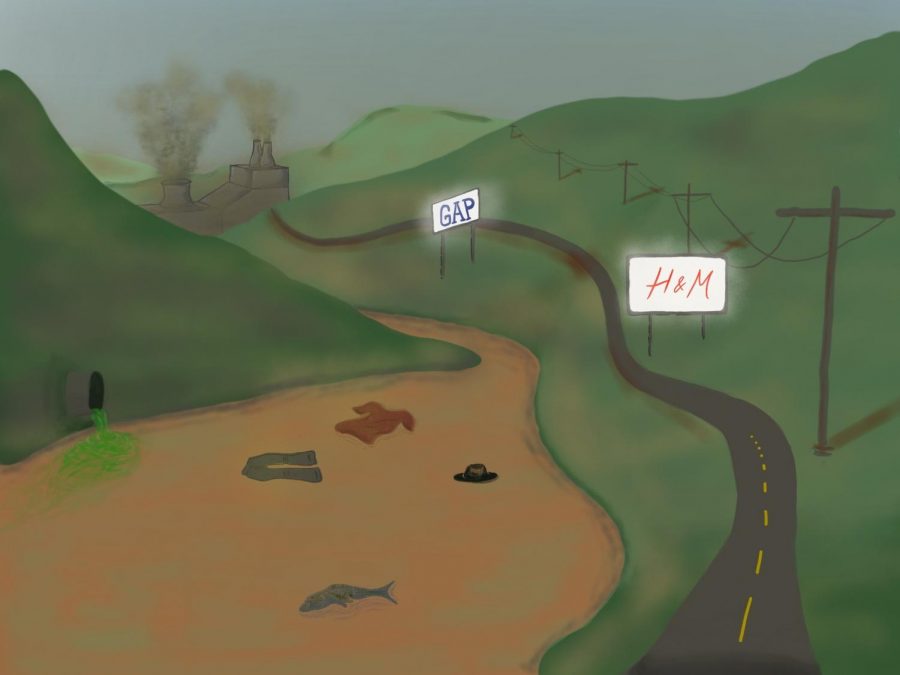The Real Cost Of Buying Clothes At A Bargain Price
January 7, 2020
The store is an orchestra of reds, yellows and blues, and these colors aren’t composed by the clothes, but rather the bold signs and tags on them reading “75% off!” and “Buy one get one free!”
Consumers rush out in waves to head to the next store and fill another bag, accidently maxing-out another card. Bags are filled to the brim and for half the displayed original price, but there is an unseen consumer tax that goes along with these impulsive investments. It’s called fast fashion, and it’s everywhere.
“Fast fashion is specifically targeted to quick turn-around,” Highland fashion design teacher Wendy Curtis said. “Runway, straight to the consumer and then into the trash.”
Fast fashion is a system based on keeping up with trends; it’s about cheap and fast. Clothes are seen on the runway, copied and then mass produced, usually under dangerous circumstances, and then sold to the consumer at an inexpensive price.
The most well-known retailors that participate in fast fashion include H&M, Old Navy, and Zara — companies that rely on stocking their shelves with new products nearly every single day.
Although it gets people the clothes they want quickly, the environmental footprint and human cost is massive and often ignored or completely hidden. The past few years have been those defined by activism. Climate strikes have taken place on global scales and students and teachers everywhere are zeroed in on being environmentally conscious, taking down oil companies, and cutting down on how much they drive. But the fashion industry is hiding in the public eye, and it has made itself indispensable, even though it is the second largest source of pollution in the world.
In the majority of garment-producing countries the biggest problem is water pollution. In the factories where textiles are made and dyed wastewater from the factory is usually just dumped into the nearest river, according to sustainyourstyle.org. The dyes and chemicals that are then contaminating the water usually consist of substances like lead, mercury, arsenic and others. This is fatal to aquatic life and also unnecessarily wastes a lot of water. These chemicals affect the health and lifestyle of the people who are living by the rivers because of how toxic the waters become over time. These chemicals can travel all around the globe because they are released into moving waters.
Not only does fast-fashion contaminate water with chemicals, it also uses a lot of water in the process and not just the disposal. Dyeing one ton of fabric takes around 200 tons of fresh water, and it takes up to 20,000 liters of water to grow one kilogram of cotton. The Aral Sea between Kazakhstan and Uzbekistan has been completely drained due to cotton growth. This is a lot of water that is being recklessly overused.
Fast fashion destroys water and contributes to several other environmental problems like greenhouse gas emissions, soil degradation, rainforest destruction, microfiber ocean pollutants and of course, waste accumulation.
According to Wrap UK, keeping a piece of clothing for an extra nine months, in active use, past when most intend to get rid of it would effectively reduce carbon, water and waste footprints by 20-30 percent. The problem is that the industry has fed into consumer society so heavily and become such a central part of life, that no one thinks it’s irregular to be constantly throwing out and buying new clothes. Buying second hand is also another way to cut down the environmental footprint of an overflowing closet.
Fast Fashion has been threatening the environment at a break-neck pace, so why is nobody talking about it? The problem of fast fashion has been discussed of course, but it seems to evade discussion in the classroom. Ever since elementary school, the advice has always been to carpool, walk to school and recycle. These are the small changes/effects that the general public are able to contribute to help prevent environmental harm, but what people put on their backs has also been proven to have an astounding effect on the environment. The problem is that most people aren’t commonly aware of its existence and all the problems it causes. As a culture, checking labels for fiber content, care instructions and manufacturing country are simply things that no one thinks about.
“I just see something cute and I’m like, I’m taking it,” Highland junior Karina Martinez said.
How does this change? How do people limit their participation in an industry that has made itself culturally indispensable? This is discussed everywhere, including within the industry itself.
How does this change? How do people limit their participation in an industry that has made itself culturally indispensable? This is discussed everywhere, including within the industry itself.
It can be surprising that some of the most environmentally conscious people are those within the fashion industry. Sites like Vestaire and Poshmark are dedicated to reselling clothes, trying to make shopping something that doesn’t harm the planet.
Lucy Yeoman, creator and founder of the magazine DREST, spoke out at the UN about the potential for fashion publications to be the source for change by reaching out to their fashion obsessed readers. She claimed that the people at the UN could reach those who already know there is a problem, while those in the fashion industry could reach out to those who had no idea there was a problem.
Some of the most well-known fashion bloggers and fashion journalists are also discussing it on their platforms. Fashion journalists Camille Charierre and Monica Ainley have multiple episodes on their podcast “Fashion No Filter” about the dangers of fast fashion, a podcast that is widely listened to by people involved in the industry.
People like Charriere, Ainley, Yeoman and the creators of Vestiaire are all people deep within the industry who are fighting for a change and working to make people aware of the problem.
Buying second hand, avoiding trends, checking fiber contents and buying from sustainable brands are all things that can have a massive impact on this problem. The less people buy, the less waste will be created. The consumer has a lot of power.






























